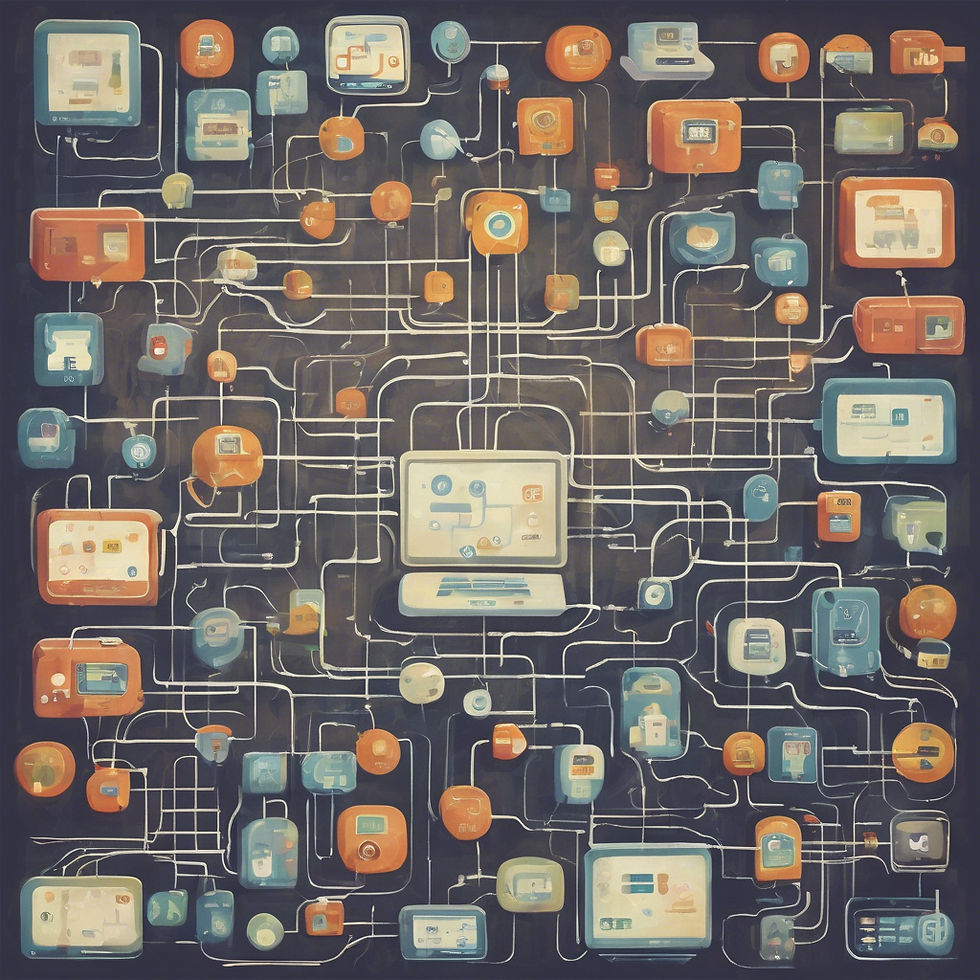The impact of Web 3.0
- spwebsite123

- Apr 28
- 5 min read
The internet is undergoing a seismic shift. From the static pages of Web 1.0 to the interactive, social-media-driven Web 2.0, we are now entering the era of Web3: a decentralized, blockchain-powered internet where users regain control over their data, digital identities, and financial transactions.
But what exactly is Web3, how far along are we in its adoption, and how is it reshaping businesses across industries? More importantly, how will it transform traditional corporate functions like finance, marketing, HR, and supply chains? Ultimately, we want to know, how will this shift the future of jobs?

Understanding Web3: The Decentralized Internet
Web3 represents the next phase of the internet, built on blockchain technology, decentralised networks, and token-based economics. Unlike Web 2.0, where tech giants like Google and Facebook control data and platforms, Web3 shifts power back to users through:
Decentralised ownership (via blockchain and Decentralized Autonomous Organizations (DAOs))
Digital sovereignty (self-custody of data and identity)
Tokenised incentives (cryptocurrencies, NFTs, and decentralised finance)
According to analysts McKinsey and researchers like GrandView research, Web3 is still in its early adoption phase, with enterprises experimenting with blockchain applications, digital assets, and smart contracts. Yet, its potential is enormous: GrandView research predict that the global Web3 market will grow from $3bn in 2024 to $33bn by 2030.
Web 3.0 is shaping industries and business functions within them. In the next two sections, we provide some examples:
How Web3 Is Reshaping Industries
Web3 is revolutionising some industries, while having a profound impact on many others: From decentralised finance to tokenized retail experiences, blockchain and smart contracts are enabling new economic models, ownership structures, and customer interactions. Here’s how a few key sectors are being disrupted:
1. Financial Services: The DeFi Revolution
Traditional banking is facing its biggest challenge yet with decentralized finance (DeFi). Web3 enables peer-to-peer transactions, eliminating intermediaries like banks and payment processors. Key developments include:
Permission-less lending & borrowing (Aave, Compound)
Stablecoins and CBDCs (government-backed digital currencies)
Automated asset management (robo-advisors powered by smart contracts)
Tokenized securities (stocks, bonds, and real estate on blockchain)
Banks and fintech firms are now racing to integrate blockchain solutions, while regulators grapple with crypto compliance and consumer protection.
2. Retail & eCommerce: Ownership, Loyalty, and Metaverse Commerce
Web3 is turning shopping into an interactive, community-driven experience:
NFT-based product authentication (Luxury brands like Gucci and Louis Vuitton combat counterfeiting)
Token-gated shopping experiences (exclusive access for NFT holders)
Metaverse storefronts (virtual shopping in Decentraland, The Sandbox)
DeCommerce (Decentralized eCommerce): peer-to-peer marketplaces with crypto payments
Retailers like Nike (with .SWOOSH) and Starbucks (via Odyssey rewards) are already pioneering Web3 loyalty programs, blending digital and physical commerce.
3. Media & Entertainment: Creator Economy 2.0
Web3 is dismantling the gatekeepers of content distribution:
NFTs for royalties (Musicians like Kings of Leon release albums as NFTs)
Decentralized streaming (Audius for music, Theta Network for video)
Fan-owned franchises (DAO-governed film and game projects)
Play-to-Earn (P2E) gaming (Axie Infinity, STEPN reward players with crypto)
Hollywood studios, record labels, and gaming giants are now exploring blockchain-based IP ownership to give creators and fans more control.
4. Energy: Peer-to-Peer Grids and Carbon Credits
Web3 is making energy markets more transparent and efficient:
Decentralized energy trading (blockchain-powered microgrids)
Tokenized carbon credits (companies like Toucan track emissions on-chain)
Smart contracts for renewable energy (automated green energy purchases)
Utilities and cleantech start-ups are adopting blockchain for traceability, ensuring that renewable energy claims are verifiable.
How Web3 Is Reshaping Business Functions
Consequently, Web3 is revolutionising the way that some business functions operate, while leaving relatively few untouched. Some examples are:
1. Finance & Accounting: The Rise of DeFi and Tokenised Assets
Web3 is revolutionising finance through Decentralised Finance (DeFi), enabling peer-to-peer lending, borrowing, and trading without traditional banks. Companies are exploring:
Tokenized assets (real estate, stocks, and commodities on blockchain)
Smart contract-based payroll (automated, transparent payments)
Corporate treasuries in crypto (MicroStrategy, Tesla, and others hold Bitcoin)
Accountants and CFOs must now understand crypto accounting, blockchain audits, and regulatory compliance in a rapidly evolving landscape.
2. Marketing: NFTs, Loyalty Programs, and Community Ownership
Brands like Nike, Starbucks, and Gucci are leveraging NFTs and token-gated communities to deepen customer engagement. Web3 marketing focuses on:
NFT-based memberships (exclusive access, rewards)
Decentralized branding (community-driven campaigns via DAOs)
Transparent ad tracking (blockchain-based attribution to combat fraud)
Marketers must now think beyond traditional social media and explore on-chain customer interactions.
3. HR & Talent Management: The Gig Economy Goes Decentralized
Web3 is transforming hiring and workforce management through:
DAO-based employment (decentralized teams working across borders)
Skill-based token rewards (employees earn crypto for contributions)
Decentralized identity verification (blockchain-based credentials)
HR professionals must adapt to remote, global, and crypto-native workforces, where traditional employment contracts may be replaced by smart contracts.
4. Service Operations: Smart Contracts & Automated service interactions
Web3 enables trust-less automation in operations, giving peace of mind to customers (and banks! alike). This is being done through new processes such as:
Self-executing agreements (smart contracts for subscriptions, warranties)
Decentralized customer support (community-driven help via DAOs)
AI & Web3 integrations (chatbots with blockchain-verified data)
Operations managers must now consider hybrid human-AI-blockchain workflows to enhance efficiency.
5. Supply Chain & Manufacturing: Transparency and Traceability
From food safety to luxury goods, blockchain ensures end-to-end visibility:
NFT-based product passports (authenticity tracking for goods)
Smart contract payments (auto-triggered upon delivery)
Decentralized logistics (peer-to-peer shipping networks)
Supply chain leaders must integrate IoT & blockchain solutions to combat fraud and inefficiencies.
The Future of Work in Web3
As Web3 grows, so do career opportunities. Roles like smart contract developers, DAO governance specialists, blockchain analysts, and Web3 marketers are in high demand (Blockchain Council, Ekolance). Professionals looking to future-proof their careers should:
Learn blockchain fundamentals (Solidity, smart contracts)
Engage in DAO communities for hands-on experience
Stay updated on regulatory shifts in crypto and DeFi.
However, those with aspirations to be leaders and thought leaders in their sector need to consider the impact and propose roadmaps and solutions for their organisation. The benefits that can be accrued to organisations are significant, while the risks that can be offset are just as as profound.
Conclusion: A Decentralised Business Revolution
With Web 3.0 adoption and development, we are seeing more than just another technological trend: it’s a fundamental rethinking of digital ownership, trust, and business models within commerce and wider still. While adoption is still in its early stages, forward-thinking companies are already leveraging blockchain, NFTs, and decentralised systems to gain a competitive edge.
For businesses, the question is no longer "if" but "how" they will integrate Web3 into their operations. Those who act now will shape the next era of the internet and reap its rewards.
Sources & Further Reading:
Nath et al (2021), Web 1.0 to Web 3.0: Evolution of the Internet
Wan et al (2023), Web3: A Comprehensive Review
Shen et al (2023), AI and Web3: Synergies and Challenges
Blockchain Council (2024), How to Start a Career in Web3
ekolance (2024) 20 Career Opportunities in Web3

Comments